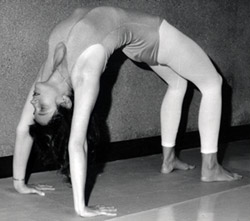Urdhva Dhanurasana: A Bridge to Fearlessness

"Fearlessness is the first requisite of spirituality."
Mahatma Gandhi
Urdhva: upwards, Dhanu: bow, Asana: posture
I love backbends. I love the energizing qualities of these exquisite postures. Many times, when feeling dull and lethargic through the grey days of winter, the practice of backbends has revitalized my body and soul, reconnecting me once again to the warm source of life within.
When I was in my early twenties, after having mastered simpler back-bending postures like Cobra and Camel, I felt irresistibly attracted to Urdhva Dhanurasana (sometimes also called chakrasana or Wheel). My teacher at the time did not teach this posture in his classes, so I started to timidly approach it on my own.
In the beginning Urdhva Dhanurasana felt like an insurmountable challenge to me. My arms and wrists were weak; I thought I would never be able to do it until one day I was unexpectedly able to raise my body from the floor higher than usual. A crack of hope flooded my soul. I persevered with my efforts and another day my body rose smoothly into the pose. I came out of it hardly believing I had done it, all by myself! I felt grace had fallen upon me.
The first lesson Urdhva Dhanurasana taught me was the power of hope and perseverance. As I continued to practice it over the years, I learned many other important lessons. I learned, for example, that in every yoga posture, the lower body must be engaged and support the opening of the upper body.
Energetically, each lower centre (chakra) that is open and fulfilling its purpose supports the opening of upper centres along the central subtle channel (sushumna). The spiral of awakening and evolution ascends. On the other hand, energy stuck in a lower centre prevents the full blossoming of upper centres.
In Urdhva Dhanurasana, if the feet are kept parallel to each other and the knees are well aligned with the hip bones, the legs feel strong and energy begins to build in the sacrum. By slightly lifting the pelvis in the posture, energy in the sacrum increases, which in turn helps the solar plexus soften and widen, allowing energy to pour into the heart centre. When the heart centre feels warm like a glowing flame, energy begins to move towards the throat and head centres.
To guide my students to experience this process in Urdhva Dhanurasana, I initially ask them to lie down on their backs and roll up to their shoulders, keeping their head and arms on the floor, hands on the pelvic bones. Coming up on their toes, I ask them to gently pull an imaginary string from the pubic bone towards the ceiling, keeping the buttocks relaxed.
Feeling their sacrum energized, the students' next step is to widen and relax the solar plexus. The use of sound and Kapalabhati breathing in this position are also helpful to release tight diaphragms.
When this foundation is well established and much preliminary work has been done to prepare the shoulders, arms and chest, students can proceed to lift the upper body, coming into the full posture, assisted or not by partners.
To counterbalance the effects of backbends, it's necessary to lengthen the spine in the opposite direction (in the pose of a child, for example). Twisting postures are also recommended.
Those who practice backbends on a regular basis often experience a sense of poise and strength. These postures have a powerful cleansing effect on the kidneys, helping release physical and emotional toxins, especially fear and anxiety.
Urdhva Dhanurasana has helped me with my personal process of confronting, releasing and transforming fear. One day I asked the Universe what I should do to release deep-seated fears held in my energy field as scars from ancient past experiences. I was given the image of a bridge over stagnated waters. I understood that this image referred to my beloved back bending posture. The message was for me to continue practicing it.
Through the power of love and surrender of personal will to divine will (ishvara pranidana), fear is ultimately conquered. By increasing the energy flow to the heart and throat centres, Urdhva Dhanurasana helps the practitioner on his or her road to fearlessness, love and self-realization.
Today in Urdhva Dhanurasana I felt courageous, my body a rainbow bridge over troubled waters. Coming out of it, deep gratitude filled my whole being. I thanked the pose for constantly revealing its beauty to me, like a bud of a rose gradually unfolding its petals, allowing my body and soul to receive its ever-renewed gifts.
Published in Yoga Outreach Magazine. Issue 4
|